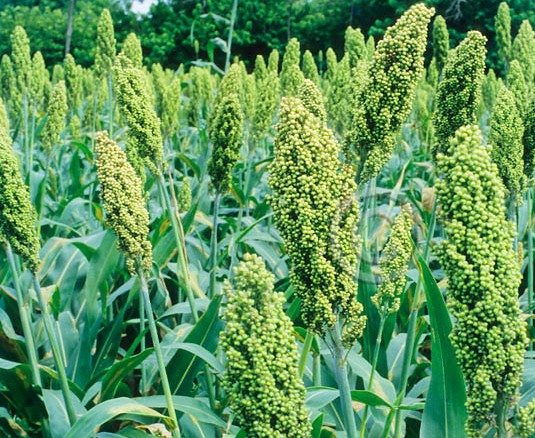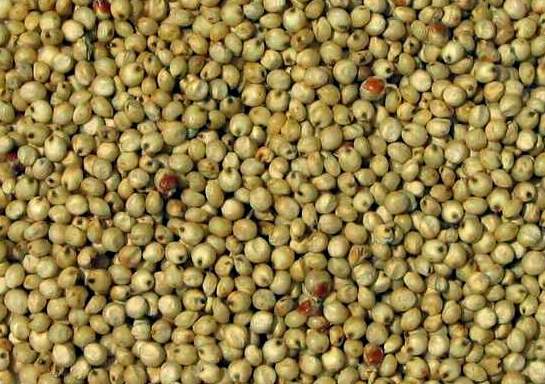Jowar Farming (Sorghum) Guide:

Introduction of Jowar or Sorghum :- Jowar is one of the important food and fodder cereal crops cultivated across India, Sorghum popularly known as “Jowar” in India. The advantage of this cereal crop is that it can be cultivated in both Kharif and Rabi season. Jowar is the 5th most important cereal crop in the world after rice, wheat, maize & barley. The nutritional value of sorghum is same as of that of corn and that is why it is gaining importance as livestock feed. Sorghum (or) Jowar is also used for ethanol production, producing grain alcohol, starch production, production of adhesives and paper other than being used as food and feed for livestock. Jowar (or) Sorghum cultivation is gaining popularity due to its nature of extreme drought tolerance. Sorghum is very nutritious just like corn and can be used as green fodder, dry fodder, hay or silage.
Health Benefits of Jowar :- Below given are some of the health benefits of Jowar.
- Sorghum/Jowar has packed with calcium, iron, potassium, phosphorous, protein and fibre.
- It provides good antioxidants.
- It contains B-vitamins like thiamin and riboflavin.
- Sorghum/Jowar is also known to be heart healthy and ‘Jowar Roti’ is widely used in India for its health benefits.
- Jowar helps in weight loss.
Major Sorghum or Jowar production states in India:- Major Jowar producing states in India are given below.
- Maharashtra
- Karnataka
- Madhya Pradesh
- Andhra Pradesh
- Telangana
- Tamil Nadu
- Gujarat
- UP
- Rajasthan
- Haryana
Commercial-Hybrid Varieties of Sorghum or Jowar:- The following varieties of fodder sorghum are recommended for cultivation in different areas of India.
| Varieties | Cultivation areas in India | Green Fodder (tones/ha) |
| Single cut | ||
| PC-6,9,23 HC- 171, 260 (Early to medium duration) | Most of the country | 30-50 |
| U.P. Chari- 1 & 2 | Uttar Pradesh., Maharashtra, A.P. &Telangana, Tamil Nadu | 30-45 |
| HC-136, Raj. Chari- 1&2 | Most of the country | 35-50 |
| Double cut | ||
| CO-27 | Tamil Nadu | 40-65 |
| AS-16 | Gujarat | |
| Multicut Types | ||
| SSG-988, 898, 855 | Most of the Country | 70-100 |
Local Names of Jowar in India:- Great Millet/Sorghum(English), Juar (Bengali, Gujarati, Hindi), Jwari (Marathi), Jola (Kannada), Jonnalu (Telugu),Cholam (Tamil, Malayalam), Janha (Oriya).
Climatic requirements for Sorghum (or) Jowar Farming:- Basically jowar or sorghum is a tropical crop. It thrives well at a temperature between 25°C and 32°C but below 16°C is not good for the crop. Jowar crop requires rainfall about 40 cm annually. Jowar is extreme drought tolerant crop and recomended for dry regions. Too much of moist and pro longed dry conditions are not suitable for jowar cultivation.
Soil Requirements for Sorghum (or) Jowar Farming:- Sorghum or Jowar crop adapts wide range of soils but grows well in sandy loam soils having good drainage. Soil pH range of 6 to 7.5 is ideal for its cultivation and better growth. The main field should be ploughed and leveled to fine tilth for weeds free sowing.
Land Selection and Field Preparation in Jowar Farming:- One should avoid rocky field and 1 to 2 ploughings followed by 2 crosswise harrowing are required to prepare a good seed bed. As the Sorghum or Jowar crop does not tolerate water lagging, the field should be prepared with well drainage.
Seed rate and Sowing in Sorghum or Jowar Farming:- Seed rate of 35-40 kg per hectare is well enough and sowing should be carried out by drilling @ row-to-row distance of 25 cm. Seed broadcasting should be avoided. The seed should not be sowed more than 2 – 3 cm depth.
Manures and Fertilization in Sorghum or Jowar Farming:- The main field should be added with 10 to15 tone of Farm Yard Manure (F.Y.M) to make the soil rich in micro nutrients. At the time of sowing, basal application of 60:40:40kg N: P2O5-K2O should be applied. Should apply 35kg N/ha top dressing 1 month after sowing. 60 to 65 kg N per hectare should be applied In low rainfall and rain fed areas at sowing time. In Sulphur deficient soils, 45 to 60 kg Sulphur /ha should be added which not only improves biomass but also quality. For any other nutrient deficiencies, soil test should be done and accordingly, apply the manures and fertilizers at the time of soil preparation.
Irrigation in Sorghum or Jowar Farming:- If the crop is sown in monsoon time (July). it may require l to 3 irrigations depending upon rains. For summer crops, 6 to 7 irrigations may be carried out due to high temperature. In South India, Rabi season crops need about 4 to 5 irrigations.
Weed control/Inter culture operations in Jowar Farming:- To control the weeds in Sorghum crop, weeder cum mulcher should be used to give 1hoeing @ 3 weeks crop stage. Should use pre-emergence application of atrazine @ 0.50 kg/ha in 650 liters of water to control the weeds effectively.
Diseases and Insects in Jowar Farming:- Sorghum crop prone to many insects and diseases.
Insects/Pests in Sorghum or Jowar Farming: Stem borer, shootfly, stem borer & sorghum midge.
How to control? Use spray of carbofuran/malathion @ 125 ml/ha, to control sorghum midge, use spray of endosulphan @ 0.075.
Diseases in Sorghum Jowar Farming : Sooty stripe, anthracnose, and zonate leaf spot.
Seed treatment is very important in sorghum farming, treat seeds with Thiram@ 3 grams/kg seed and this takes care of almost all diseases. Spray carbendazim @ 5grams /liter water to control anthracnose disease in early stages. Summer sown crop is very prone to shoot fly. For this carbofuran 3G@ 3 to 4 kg/ha should be applied to control shoot fly at sowing time. To control or avoid stem borers, crop should be sown during July season. Using spray of endosulfan @ 0.05% , 2 to 3 times at 10 to 14 days interval is also effective.
Harvesting of Jowar:- The crop will be ready in single cut varieties for harvesting @ 65 to 75 days after sowing (50%, flowering stage). In multi cut varieties, first cut should be done @ 45-50 days and subsequent cuts should be carried at 1 month intervals.

Yield of Jowar:- Good farm management practices and good variety of Sorghum/ Jowar can yield up ro 1000 kg/ha.
Want Information on Goat or Sheep Farming? Read Here.
One thing remained un-answered that after the rain is over and we missed that before rain gap of sowing can we do sowing during the rain time ? will it grow or not grow ? in rain time ?